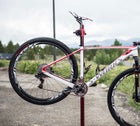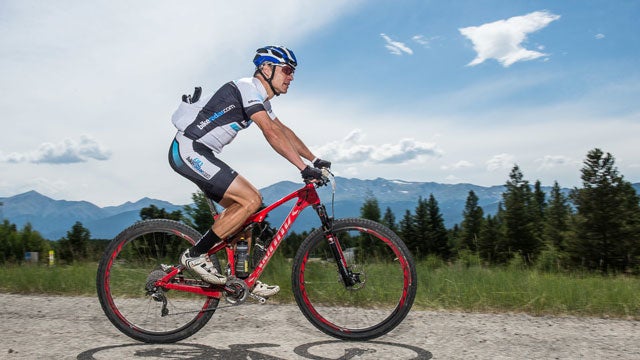No reasonable person would climb aboard a new bike for the very first time at a race, especially one as long and demanding as the . Any number of problems could derail months of preparation: injury because of poor position, new setup mechanicals (think: cable stretch or brake bubbles), or pain from unfamiliar components.
 Pre-race wash of a 2014 Stumpjumper.
Pre-race wash of a 2014 Stumpjumper. The 2014 Stumpjumper equipped with SWAT box.
The 2014 Stumpjumper equipped with SWAT box. The mass start of the race.
The mass start of the race.But when Specialized said they were launching the 2014 Epic and Stumpjumper at Leadville, I didn’t hesitate to sign up.
That’s partly testament to my conviction in Specialized mountain bikes, especially the Epic. This has to be one of the most winning platforms in cross-country mountain biking, and it was the first 29er to win a World Cup and a World Championship. ���ϳԹ��� has heaped commendation on numerous iterations of the Epic over the years, including a review in which I called the 2011 29er model “the finest cross-country bike that money can buy.” I have tested nearly every XC bike on the market, and I have raced an Epic since I first purchased one in 2007.
So how could I possibly go wrong on the 2014 edition?
Yet the Epic was no forgone conclusion. I hemmed and hawed over whether to ride it or the Stumpjumper. Leadville runs predominantly on fire roads and climbs more than 12,000 feet in elevation, which suggests the lower weight and better power transfer of a hard tail. But the comfort of full suspension on such a long day, plus the decreased risk of flatting, had me second-guessing. Beyond that, both new models had significant upgrades from last year.
The S-Works model of the Stumpjumper gets a lighter carbon layup (claimed weight: 1,050 grams), revised geometry for quicker steering, and a 142x12mm thru-axle rear end for stiffness and responsiveness. The top end is spec’d with the new Roval Carbon SL 29 wheels, which have a wider rim profile than previous models but weigh a scary light 1,370 grams.
Specialized has had some durability issues with its previous top-shelf carbon rims, so it will be interesting to see how these lighter, burlier wheels hold up. The S-Works also gets the custom Rockshox Sid WC fork with Specialized’s Brain technology and is plumbed for internal cables. All said, it’s a rocket ship, tipping the scales at under 19 pounds for a size medium. It was hard to argue against this bike for Leadville.
The Epic sees even more significant changes than the Stumpjumper for 2014. Most noticeably, the rear shock is around 25 percent smaller and tucked higher into the frame. Not only does this allow space enough for two 24-ounce water bottles in the main triangle—a boon for endurance racers—but it also makes room for Specialized’s new Storage, Water, Air, and Tool (SWAT) solution.
This triangular plastic box holds a tube, tire lever, air cartridge, and inflator head, and bolts onto the frame at a third rivnut on the down tube. Also included in the SWAT concept is a multitool that tucks into a hidden socket above the shock, as well as a chain tool (and spare links) that doubles as a headset cap. With the extra gear (just under a pound) and the Roval Carbon SL 29 wheels, the S-Works Epic comes in under 22 pounds.
In addition to the standard model, for the first time ever the S-Works Epic will be available in a second, World Cup variation. The World Cup has a steeper head tube angle, shorter and more beefed-up chain stays, 95mm of travel out back instead of 100mm, and will be compatible with 1×11 drivetrains only. Its suspension is tuned stiffer than the standard Epic (though not as stiff as previous editions of the bike), making it a finely honed race machine only. The World Cup is SWAT compatible but does not come equipped with the kit. A stock size large is a stunning 19.9 pounds.
These were some fine bikes to choose from, and I eventually settled on the standard S-Works Epic, partly because of my familiarity with it and partly because it’s what the guys at Specialized counseled. I didn’t regret the choice.
This Epic feels considerably different than previous generations. What sets this bike apart from everything on the market is the Brain technology, which uses an inertia valve in the fork and shock to turn the suspension on and off when you need it—there are no dials or levers to worry about. This iteration of the Brain is more refined than ever, with a smoother transition between on and off. The firmest settings aren’t as stiff as in the past, which may turn off riders who liked that locked-out feel when climbing. But Specialized says the small bump compliance and added give actually speeds you up even when going uphill. (They also offer a custom tuning program for riders who want their shocks stiffer.)
On the Leadville course, I immediately noticed the bike’s supple feel. It tracked great and allowed me to climb in the saddle almost exclusively on the bumpy, dirt road ascents. I did, however, find the added squish in the fork a little off-putting when I was climbing out of the saddle on pavement.
Specialized has also moved the threshold dial from the bottom of the fork to the top, meaning that you can now make the front end ride softer or stiffer on the fly. At first I thought this negated the whole advantage of the Brain, but then I realized that it simply adds more control. Still, now that that dial is topside, I hope that Specialized will consider a bar-mount lever as I found myself struggling to change the settings on rough descents more than once.
Eventually, I just left the fork all the way firm. And the bike was still razor sharp in corners and blazing fast on descents, where I hit nearly 50 miles per hour several times. Handling is as crisp and aggressive as ever, and the new gossamer wheels felt like cheating. I rode across the line faster and fresher than I ever have at this race.
Afterward, I briefly wondered whether I might have been faster on the Stumpjumper. Then came word from the . Whereas Alban Lakata won last year’s edition in six hours and 32 minutes aboard a hard tail, he rode full suspension in 2013 and set a new course record of six hours and four minutes. It makes you think that as engineering continues to improve, the days of the hard tail are numbered.
This was my third time racing Leadville, and I trimmed nearly 44 minutes from my previous best to finish in 7 hours and 33 minutes. It’s impossible to say that’s all because of the bike, but it’s clear that the new Epic didn’t hurt any. Once again, I ride away feeling that for XC and endurance racing, there’s no better bike out there.
We’ll look forward to scrutinizing that statement as the test bikes, including at 2014 Epic, begin arriving early this fall.


